State of Manufacturing: Strong, But Not Guaranteed
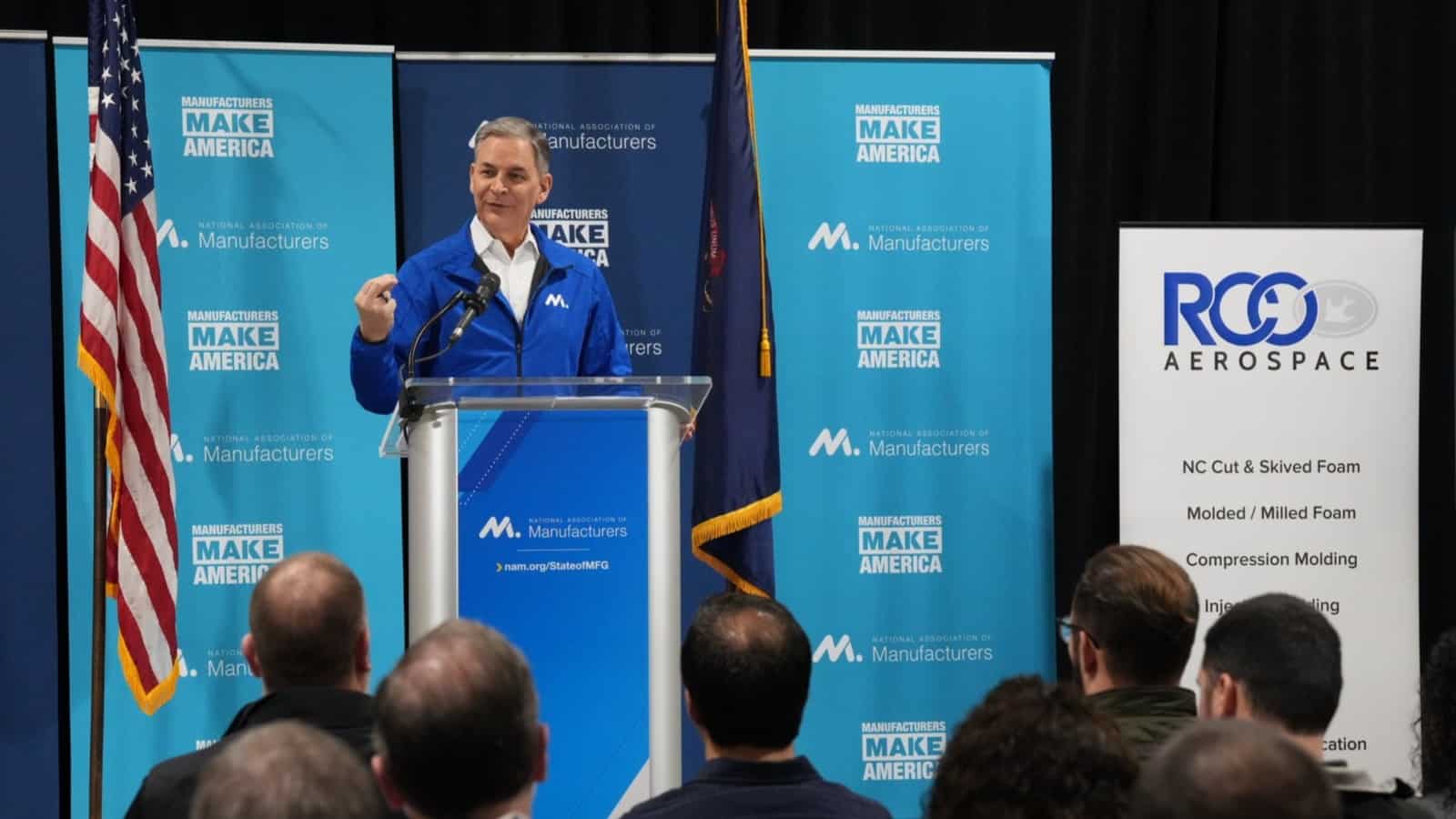
What’s the state of manufacturing in the U.S.? Strong and resilient—but under threat.
That was the message delivered by NAM President and CEO Jay Timmons and other speakers at the NAM’s 2024 State of Manufacturing Address at RCO Engineering in Roseville, Michigan, on Thursday.
- Attending the address were nearly 100 RCO Engineering team members—some of whom are second- or even third-generation manufacturing workers—as well as local education leaders, including Macomb Community College President James O. Sawyer IV and Macomb Intermediate School District Superintendent Michael R. DeVault.
- The address was the keystone event of this week’s launch of the 2024 Competing to Win Tour, an opportunity to visit local manufacturers and report on where the industry stands at the start of 2024.
A place of strength: “The state of the manufacturing industry depends on the people in it,” Timmons said in remarks covered by POLITICO Influence (subscription). “And we are now 13 million strong—the largest in more than 15 years. If we can continue on this trajectory, this resurgence, imagine what the state of manufacturing might look like in 2030.”
- Johnson & Johnson Executive Vice President and Chief Technical Operations & Risk Officer and NAM Board Chair Kathy Wengel echoed that sentiment in her opening remarks. “Manufacturers are improving the quality of life for everyone. … Together, we can lead the way.”
- And Michigan Manufacturers Association President and CEO John Walsh told the audience at RCO Engineering, “You are making parts here that are going everywhere. It’s a phenomenal story for us in Michigan. It not only helps you as employees here, but it helps your families, it helps your communities. It builds our state. It builds our nation.”
- “Manufacturing … is an industry that is vital to our economic competitiveness,” said Macomb County Executive Mark Hackel. “In Macomb County, we’re not just witnessing the growth of manufacturing; we’re actively contributing to it. What we are doing here is creating an environment where innovation thrives and where manufacturers can grow as well as compete.”
- RCO Engineering General Manager Jeff Simek agreed. “The manufacturing brand is coming back, and it’s coming back alive—and you guys are a big, huge piece of that,” he said to loud applause.
Fork in the road: But continued manufacturing strength isn’t guaranteed, Timmons said. Rather, it’s in large part contingent on sound policy decisions by U.S. leaders.
- “We will head in the wrong direction if Congress lets taxes go up on small businesses when rates expire next year,” Timmons said. “Or if they hit you with even more regulations—regulations even harsher than ones they have in Europe. Or if they fail to solve the immigration crisis because they put politics over good policy. Or choose trade barriers rather than trade agreements, or … abandon our allies overseas and put our national security at risk.”
- The recent regulatory onslaught by federal agencies—which Timmons discussed with Fox Business earlier this week—must stop and be replaced with sensible rulemaking done in cooperation with manufacturers, he said.
- He cited the Environmental Protection Agency’s recently finalized, overly stringent standard for particulate matter and the Biden administration’s decision to freeze liquefied natural gas export permits. This “forc[es] our allies, like Europe and Japan, to buy dirtier energy from countries we can’t trust, potentially enriching the likes of Russia … undercut[ting] our most basic national security objectives,” Timmons said.
No new taxes: The NAM’s message to Congress on taxes is simple: “No new taxes on manufacturers in America,” Timmons said.
- “And while we’re at it, Congress should bring back some of the tax policies that made it easier for manufacturers to invest in the future.”
On immigration: The U.S. needs a common-sense solution to immigration, and it needs it now, Timmons said.
- While manufacturers may not like every piece of the bipartisan border deal that was recently killed in the Senate, “here was my test: Does it make us more secure than we are today? Yes. Does it make our workforce stronger than it is today? Yes. And does it help our allies overseas? Yes,” said Timmons.
Come what may: No matter what the November elections bring, manufacturers will continue to do the jobs so many people depend on them to do, Timmons concluded.
- “Our commitment is to work with anyone, and I truly mean anyone, who will put policy—policy that supports people—ahead of politics, personality or process. We will stand with you if you stand with us in advancing the values that have made America exceptional and keep manufacturing strong.”
Reports: Obesity a Challenge for Manufacturing Employers

Obesity is costing U.S. companies and their workers hundreds of billions of dollars a year, according to a new report, the findings of which are in line with those of a 2023 NAM report on employer-sponsored health care.
What’s going on: “Obesity and overweight are estimated to have caused a staggering $425.5 billion in economic costs to U.S. businesses and employees in 2023, according to a report released by GlobalData Plc, a leading data and analytics company,” MarketScreener reports.
- The findings of the GlobalData report, “Assessing the Economic Impact of Obesity on Employers: Identifying Paths Toward Work Force Health and Well-Being,” are consistent with those of a recent NAM report, “ Manufacturers on the Front Lines of Communities: A Deep Commitment to Health Care ,” which notes significantly higher health care costs for individuals who are obese or carry excess body weight.
- “These additional costs account for $170 billion to $200 billion in annual spending in the U.S., making [these conditions] a significant cost for employers,” according to the NAM report.
Why it’s important: Obesity can make workers more prone to absenteeism (taking time off) and presenteeism (being less productive while on the job), both of which come with a significant price tag, according to the reports.
- Some 46.1% of manufacturer respondents to an NAM survey said obesity affected their workplace productivity and employees’ ability to complete their job functions.
- Absenteeism costs employers $82.3 billion each year, with presenteeism accounting for an additional $160.3 billion, according to the GlobalData report.
Impact on manufacturing: The economic impact of excess body weight on manufacturing is the fourth highest of the seven industries examined by GlobalData, at $44.5 billion annually.
What can be done: Manufacturers care deeply about ensuring their employees have access to high-quality, affordable primary care providers who can help employees manage their weight through personalized interventions like diet, exercise, behavior modification, medications and surgery.
The last word: “Manufacturers support efforts to continue to destigmatize these chronic health challenges and approach them like any other condition so that workers and their families feel comfortable choosing from the full suite of available treatment options in order to live healthier and more productive lives,” said NAM Vice President of Domestic Policy Charles Crain.
Trend of the Week: Data in Action

Everyone knows that data is an indispensable resource, but putting it to use is a whole different challenge from collecting it in the first place. Here’s what you need to know about today’s manufacturing trend, the industry’s increasing reliance on data-driven insights.
What manufacturers should do: According to NAM experts, manufacturers seeking to make the most of their data should focus on five key steps:
- Understand how to gather data to enable meaningful analytics.
- Improve data governance for quality and security.
- Determine what data are important to your business and operations.
- Learn how to assign value and view the data through the appropriate lens.
- Know how to use data to make business decisions.
Expert opinion: According to John Petrusick, managing director of NTT’s manufacturing data and analytics practice, companies should consider working backward to some extent, and start by thinking about which business processes the data will influence—and how.
- “Most of us have grown up in a world where we think of data as a flow from source to consumer, or left to right,” he noted. “In such thinking, we have generated analytics and insights historically by first thinking about ‘what data do I have?’ But what if we thought about generating analytics and insights by thinking ‘right to left’?”
Resources for you: Looking for more resources on data management? Start with these NAM offerings:
- This Master Class Series from the Manufacturing Leadership Council (the NAM’s digital transformation division) will guide you through case studies and best practices regarding data analysis.
- CONNEX Marketplace uses data visualization tools to help you make connections to suppliers and buyers, offering exceptional insight into your supply chain.
- The NAM’s Power of Small newsletter keeps small and medium-sized manufacturers up to date on advocacy, policy, digital trends and much more. Check it out.
Read the full 2024 trends report here.
Primary Goals: NAM Hits the Road in 2024
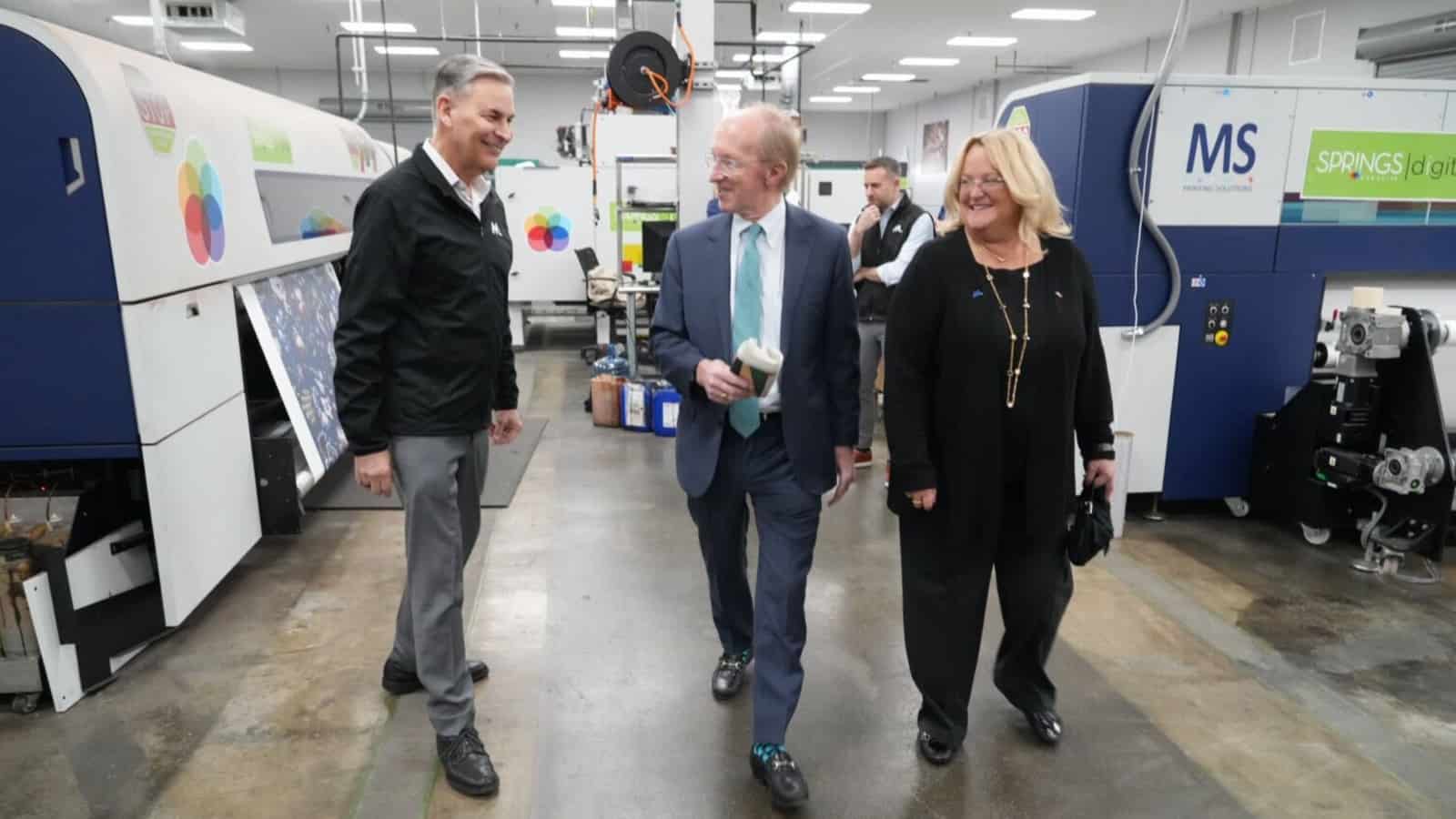
As candidates look to claim the support of manufacturers in 2024, the NAM launched its year-long 2024 Competing to Win Tour in South Carolina, days ahead of the South Carolina GOP primary.
- The tour spotlights the issues critical to winning not just manufacturers’ votes but also more manufacturing in the U.S.
Why it’s important: “We came to South Carolina to showcase the people and stories behind our industry and to translate their perspectives into action that will make our industry and country stronger,” said Johnson & Johnson Executive Vice President and Chief Technical Operations & Risk Officer and NAM Board Chair Kathy Wengel, who joined NAM President and CEO Jay Timmons, South Carolina Chamber of Commerce President and CEO Bob Morgan and South Carolina Manufacturers Alliance President and CEO Sara Hazzard on the first day of the tour.
- “Building these strong relationships beyond Washington, D.C., in the cities and states driving our sector deepens our understanding of regional challenges and reinforces the NAM as the leading voice representing all manufacturers, large and small,” Wengel added.
The launch: The tour began at Milliken & Company’s headquarters in Spartanburg on Wednesday, a poignant reminder of the importance of just one global technology-based manufacturer to lives, innovation and progress.

- The company’s 3,200 associates in the Palmetto State, as well as its broader U.S. and global team, make everything from safety gear and wound dressings and bandages to eco-conscious materials and technological innovations, such as digital printing, flooring, sustainable coating additives and more.
- “The average person touches about 30 to 50 [Milliken products] a day,” said Milliken President and CEO Halsey Cook.
- “Milliken embodies what we believe: manufacturing makes a positive difference. Their commitment to sustainability, ethics (named a World’s Most Ethical Company 17 years running) and a people-first workplace create a ripple effect,” said Timmons. “It’s why we need everyone supporting the success of manufacturers in South Carolina and the United States—to empower companies just like Milliken and help us grow more of them right here in America,” Morgan emphasized.
- “Milliken is a remarkable brand ambassador for the entire manufacturing industry in the United States,” summed up NAM Managing Vice President of Brand Strategy Chrys Kefalas. “As Michael Brown, Milliken’s executive vice president of operations, conveyed to us, the company is showing that digital transformation and artificial intelligence can be a force for good, helping its people leverage data analytics, for example, accelerating innovation and making modern manufacturing even more exciting for the next generation to be a part of.”
A boom story: Springs Creative Products Group CEO Derick Close, who heads several small enterprises in South Carolina, brought the NAM tour to Fort Lawn, South Carolina, where state-private partnerships and sound competitiveness policies have led to a boom in manufacturing investment and jobs.
- According to Close, recent investments in the community exceed $2.5 billion and stand to add 1,500 new jobs.
- Close, who is an economic development champion for South Carolina, took time to brief the group on how the area is ground zero as well in the story of the revival—and revolution—happening for the U.S. textile manufacturing sector, showing that U.S.-based textile manufacturers can compete against the rest of the world at quality, speed and price, so long as misguided policies don’t impede current advances. Springs Creative’s digital printing facility, which the NAM toured, is just one example. Springs Creative produces fabrics for such companies as Disney, Tempur-Pedic and Walmart.
- An added highlight of Close’s showcase was a tour of the new 1.5-million-square-foot, $423 million E. & J. Gallo wine and spirits production and distribution center—a testament to U.S. ingenuity and the more than 275 jobs it’s already created (with more on the way) to produce the best-selling spirit in the U.S.
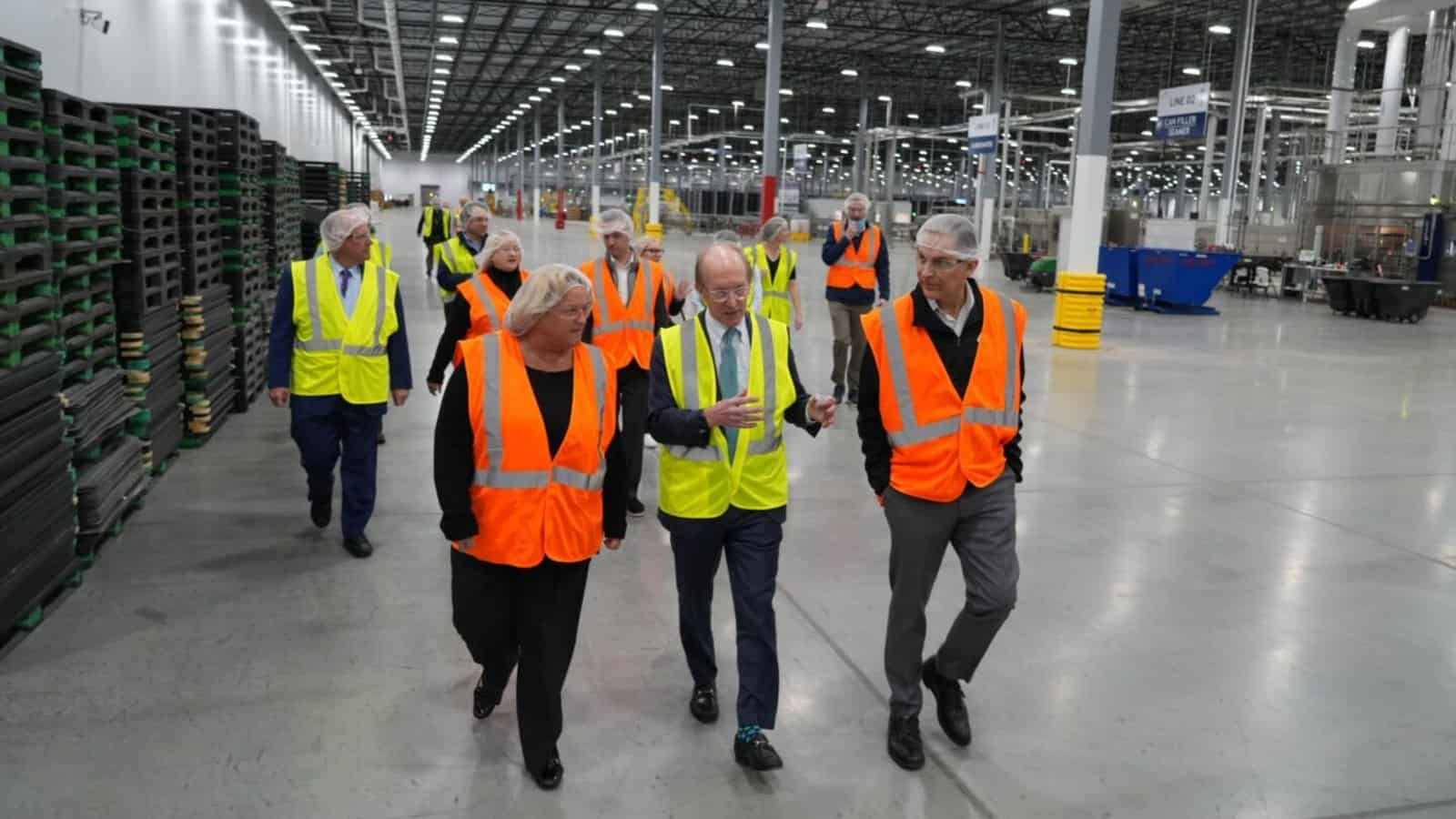
The message: The discussions at Milliken and Springs Creative focused on the need for policies that support manufacturing’s growth, from R&D incentives and competitive taxes to sensible regulations, resilient supply chains and permitting reform, to workforce development, including immigration reform, and energy policy.
The platforms: As newsrooms dwindle, the NAM is stepping into the breach, using its platforms, like NAM.org, social media and its email newsletters, including Input, to amplify manufacturing’s narrative. It’s a bid to ensure that as policymakers and candidates court manufacturers, they’re armed with real stories and concrete policy needs from the ground.
Looking ahead: The tour will continue across the United States, gathering insights and stories to bolster the NAM’s advocacy efforts. Next up: the Competing to Win Tour brings the NAM State of Manufacturing Address to Roseville, Michigan, as well as to Sanders Chocolate and Triumph Gear Systems in Macomb County on Thursday.
GlobalFoundries to Get $1.5 Billion in CHIPS Funding

Semiconductor maker GlobalFoundries Inc. will be the first recipient of funding under the NAM-supported 2022 CHIPS and Science Act, CNBC reports.
What’s going on: “The U.S. government is awarding $1.5 billion to GlobalFoundries to subsidize semiconductor production, the first major award from a $39 billion fund approved by Congress in 2022 to bolster domestic chip production.”
- The Malta, New York–based GlobalFoundries—the largest U.S. manufacturer of customized semiconductors and the world’s third-biggest chipmaker—plans to use the funds to build a new chip-production facility in its hometown and expand existing facilities there and in Burlington, Vermont.
- The Malta facility will manufacture high-value semiconductors not currently produced in the U.S., Commerce Secretary Gina Raimondo said.
- In addition to the grant, the federal government is also offering GlobalFoundries $1.6 billion in loans.
Why it’s important: “The chips that GlobalFoundries will make in these new facilities are essential chips to our national security,” Raimondo said on Sunday, adding that the “agency is in active talks with numerous applicants and expects to make several announcements by the end of March.”
- In January, Commerce announced it was awarding defense contractor BAE Systems $35 million under the CHIPS Act.
Our role: The NAM—which helped secure several manufacturing priorities in the final CHIPS Act legislation—welcomed the news.
- “Congratulations to [GlobalFoundries]!” the NAM wrote in a social post Monday. “The NAM-championed CHIPS and Science Act is strengthening manufacturing in the U.S. We will continue to work with Congress and the White House to enact permitting reforms that will help speed the construction of these vital projects.”
NAM to House: Overturn Air Standard
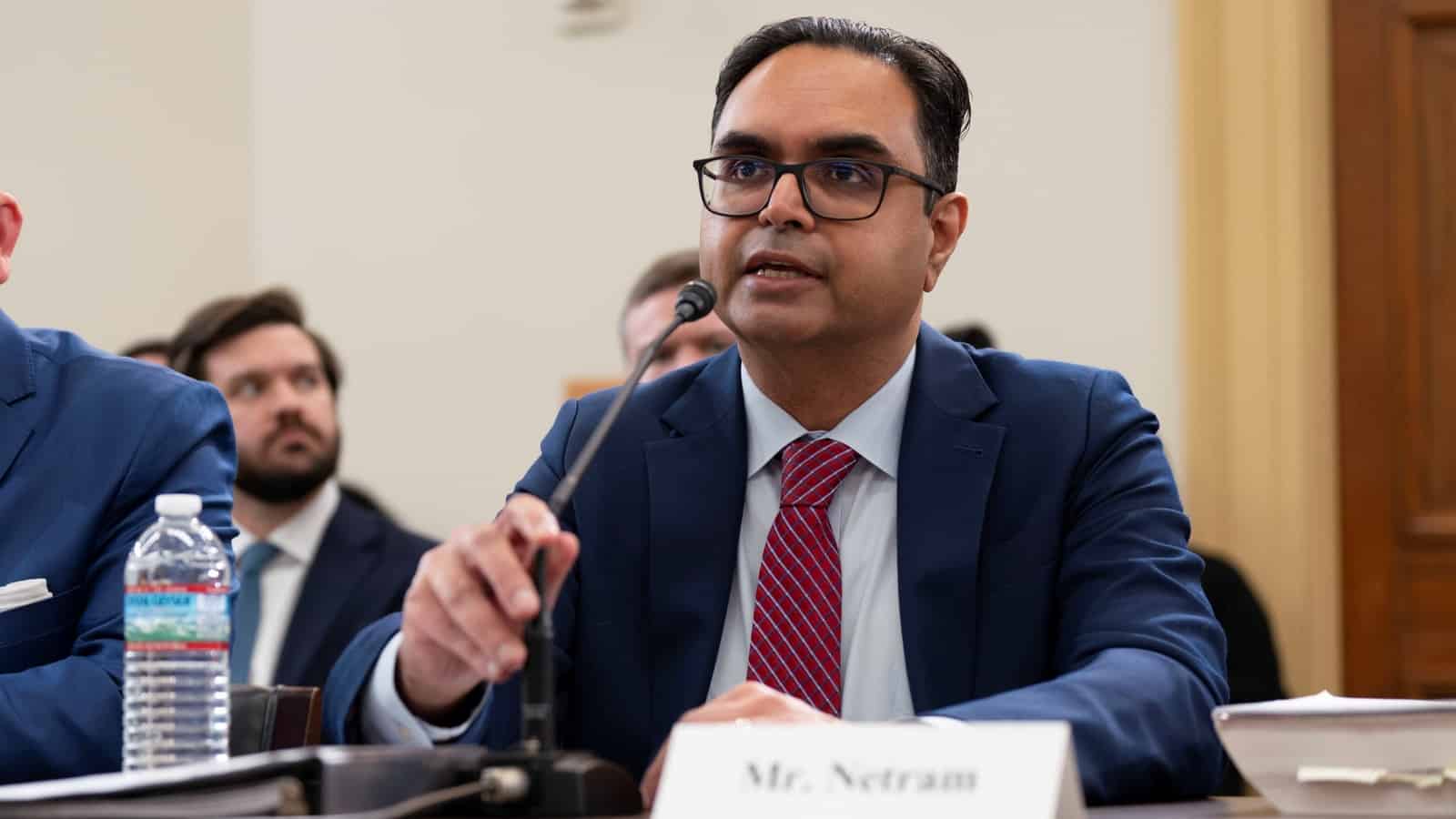
The Environmental Protection Agency’s recently finalized standard for particulate matter (PM2.5) will hamstring U.S. economic growth, job creation and competitiveness—and it must be reversed, the NAM told the House Thursday.
What’s going on: “The EPA’s unworkable PM2.5 standard … of 9 [micrograms per cubic meter of air] is in line with background levels of particulate matter in many parts of the country,” NAM Managing Vice President of Policy Chris Netram told committee members during “Safeguarding American Prosperity and People’s Livelihoods: Legislation to Modernize Air Quality Standards,” a hearing of the House Energy and Commerce Subcommittee on Environment, Manufacturing and Critical Materials.
- “In other words, the standard is now so low that companies will be expected to reduce their emissions below what naturally occurs.”
- The result of an overly stringent National Ambient Air Quality Standards level: Large swaths of the U.S. will be forced into “nonattainment” status, making permitting for critical infrastructure nearly impossible and all but guaranteeing job cuts, not growth, Netram said in his testimony, which Bloomberg (subscription) covered.
Why it’s important: A particulate matter standard of 8 micrograms per cubic meter of air—only slightly below the newly finalized level—would result in a loss of up to $200 billion in economic activity and almost 1 million jobs, according to a recent NAM study.
- As far as global competitiveness is concerned, the new limit effectively cuts America off at the knees, Netram continued. “Europe’s current PM standard is 25; China’s is 35. If we want the next manufacturing dollar to be spent in America rather than abroad, a standard of 9 is simply not feasible.”
What should be done: Lawmakers should introduce a Congressional Review Act resolution to overturn the new standard as soon as possible, Netram urged. The NAM also highlighted key NAAQS reform policies Congress is considering:
- Extend the EPA review period to 10 years.
- Allow the EPA to count wildfire mitigation as exceptional “rather than holding manufacturers accountable for PM they can’t control.”
- Require the EPA to consider the economic effects of a tightened standard.
NAM: Regulatory Onslaught Disproportionately Hits Small Manufacturers
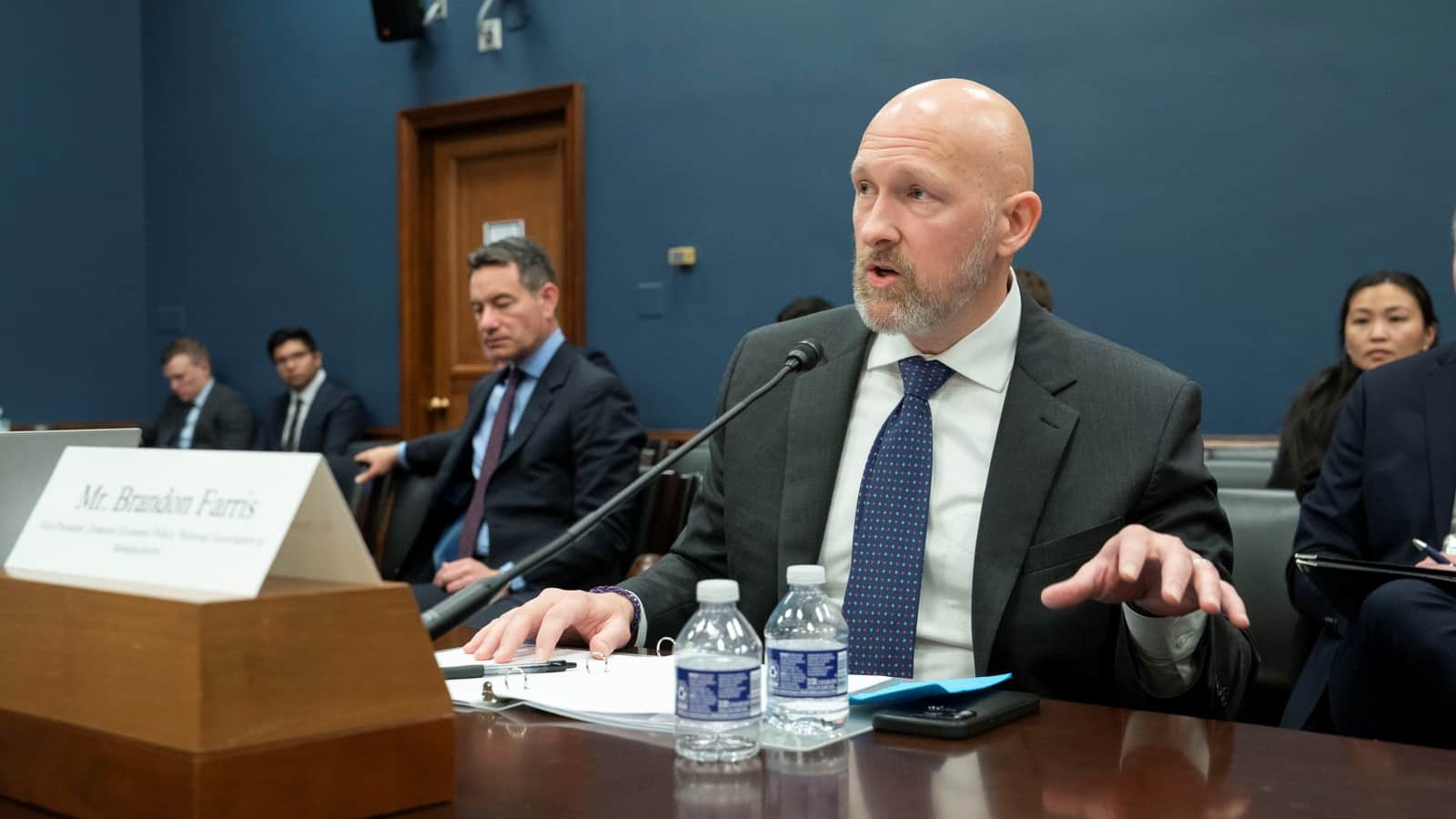
Small businesses are a critical part of both manufacturing and the U.S. economy at large, but the federal government’s costly regulatory onslaught is putting their continued existence at risk, the NAM told House lawmakers Wednesday.
What’s going on: “In the manufacturing sector, the majority of firms are small,” NAM Vice President of Domestic Policy Brandon Farris told the House Committee on Small Business during the hearing “Burdensome Regulations: Examining the Impact of EPA Regulations on Main Street.”
- “These firms are the backbone of the manufacturing supply chain, often producing key components for larger firms … [but] manufacturing faces significant headwinds in the form of the cost, complexity and uncertainty associated with overreaching and burdensome federal regulations.”
Why it’s important: The seemingly endless conveyor belt of new federal rules for the industry is costing manufacturers “shocking” amounts, disproportionately imperiling manufacturers—small ones in particular, Farris continued.
He cited NAM data finding that:
- The federal cost of regulations for manufacturers in 2022 was roughly $350 billion, a 25% increase from 2012; and
- The average manufacturer in the U.S. pays $29,100 per employee per year to comply with federal rules, while for the average small manufacturer, that price is $50,100.
Where it’s coming from: Farris cited other recent examples of onerous federal rulemaking, including:
- The Environmental Protection Agency’s recently finalized update to the National Ambient Air Quality Standard from 12 micrograms per cubic meter of air to 9 micrograms, a level approaching naturally occurring levels in many parts of the U.S., according to Farris, and one that “will make manufacturing in the U.S. less competitive globally”;
- The Department of Energy’s recent freeze of liquefied natural gas export permits, which, given increased European reliance on U.S. LNG since the start of Russia’s war in Ukraine, risks “leav[ing] our allies [and] our manufacturers in the cold”; and
- The Securities and Exchange Commission’s proposed climate disclosure rule, which “would increase manufacturers’ compliance costs dramatically, divert resources from job creation and growth, expose companies to increased liability, reveal proprietary and confidential information and ensnare wide swaths of the manufacturing supply chain.”
What must be done: Manufacturers aren’t asking legislators to cut corners, Farris said.
- Rather, they are seeking “regulatory certainty that can guide investment decisions and ensure that this country’s economic competitiveness is not outpaced or outflanked or overtaken by nations that do not share our values.”
To learn more about the high cost of overregulation, visit Manufacturers for Sensible Regulations, a coalition created by the NAM and members of the NAM’s Council of Manufacturing Associations and Conference of State Manufacturers Associations that’s intended to address the recent regulatory onslaught from federal agencies.
U.S. “Very Concerned” About Critical Minerals

The Biden administration is “very concerned” about U.S. reliance on China for critical minerals, U.S. Energy Secretary Jennifer Granholm said Wednesday, according to CNBC.
What’s going on: China’s dominance in the world’s critical minerals supply chain is “one of the pieces of the supply chain that we’re very concerned about in the United States,” Granholm told the news outlet on the sidelines of the International Energy Agency’s 2024 Ministerial Meeting in Paris.
- China produces approximately 60% of all rare earth elements, which are critical to alternative-energy technologies, such as electric vehicles.
Why it’s important: “As part of a rapid uptick in demand for critical minerals, the IEA has warned that today’s supply falls short of what is needed to transform the energy sector,” according to the article.
What the administration is doing: Both production and processing of critical minerals “have to be addressed,” Granholm said.
- “And that’s why we are working very closely to ensure that we have identified which raw materials [or] critical minerals we need to be able to do our transition to a clean energy economy.”
The NAM says: “Other countries are taking all possible measures to develop domestic sources of critical minerals, and it should be a wake-up call to the U.S. that we need to be doing the same,” said NAM Vice President of Domestic Policy Brandon Farris. “We also need to reform our broken permitting system to get these projects operational as soon as possible.”
Trend of the Week: Sustainability Under Scrutiny

Manufacturers have long prioritized sustainability in their operations, but 2024 will bring new attention to the industry’s efforts. As we continue to explore the major manufacturing trends that will shape the industry this year, here’s what you need to know about this key development.
What manufacturers should do: Manufacturers looking to create strong sustainability plans to meet the expectations of regulators, boards and consumers should start by taking these steps, according to the NAM’s experts.
- Craft an overall organizational sustainability plan with metrics and reporting.
- Make changes and upgrades to support energy and resource efficiency, as well as reduce waste and emissions.
- Focus on sustainable products and packaging in addition to sustainable processes.
- Improve product reclamation or recycling in the circular economy.
Expert opinion: According to UL Solutions, company boards have a particularly key role to play in developing sustainability plans.
- “Boards of directors are bound by their fiduciary responsibilities to shareholders, but savvy directors also recognize that environmental and other ESG-linked risks and opportunities are vital to the long-term health of their organizations,” UL notes.
Resources for you: Check out these NAM resources to learn more about sustainability and compliance:
- NAM Energy will connect you with an adviser to create an energy management strategy that will help you cut costs and reduce your environmental impact.
- This podcast from Milliken & Company’s director of research, compliance and sustainability is an excellent case study for manufacturers seeking to remove or remediate PFAS chemicals.
- Dig into the NAM’s extensive collection of policy explainers, on everything from the Environmental Protection Agency’s regulation of particulates to the Securities and Exchange Commission’s regulation of climate disclosures.
Read the full 2024 trends report here.
Timmons Talks Trade, Tariffs, Democracy in Washington, D.C.
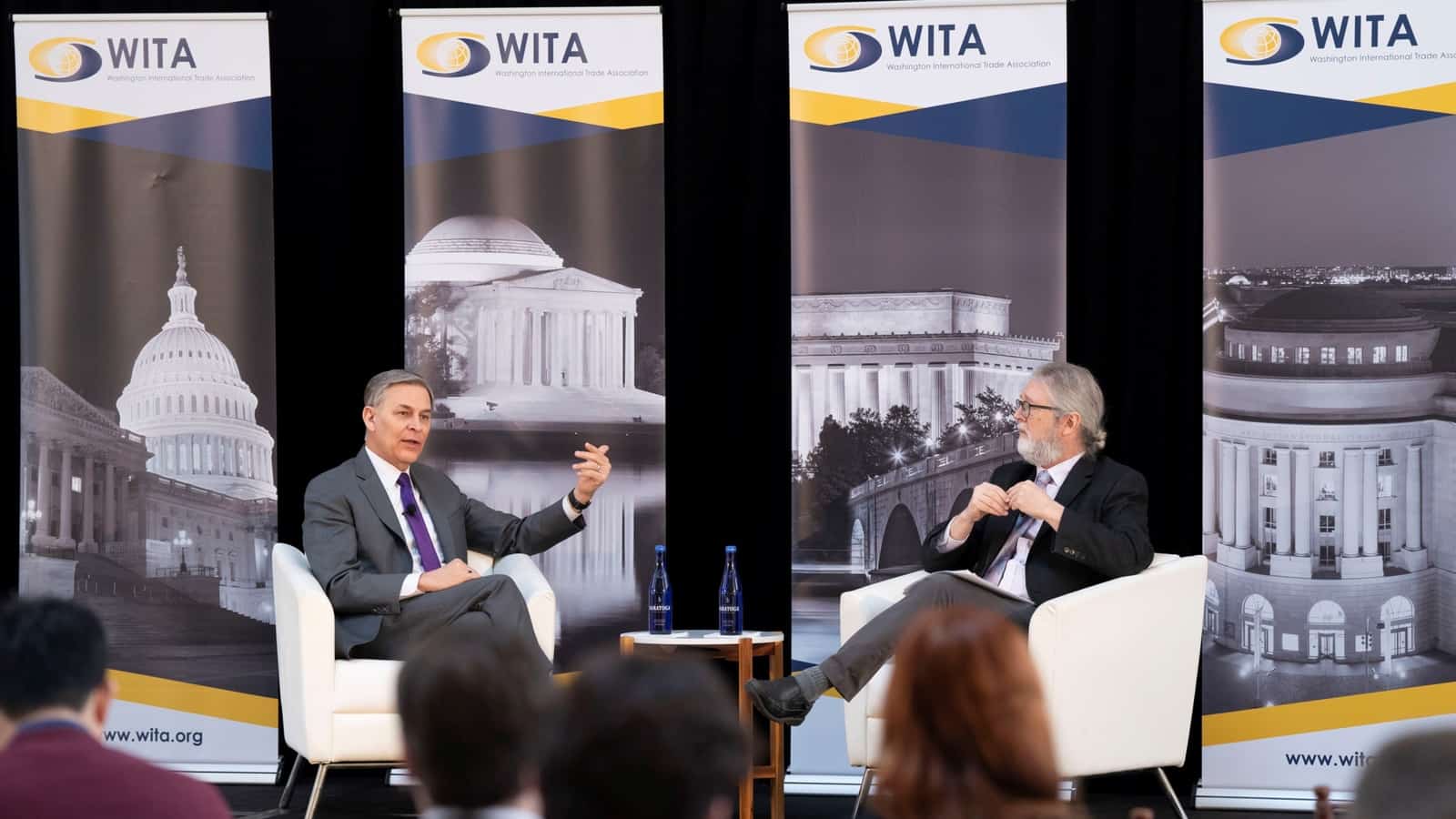
U.S. competitiveness on the world stage, trade agreements, intellectual property, democracy and regulatory certainty—these were just some of the topics NAM President and CEO Jay Timmons covered in a Tuesday interview with POLITICO’s Doug Palmer during the 2024 Washington International Trade Conference.
- The meeting was attended by senior U.S. trade officials and foreign ambassadors and hosted by the Washington International Trade Association in Washington, D.C.
Safeguarding IP: With the World Trade Organization’s 13th Ministerial Conference coming up later this month, Timmons discussed the damage that would result from one of the meeting’s expected agenda items: an expansion of a 2022 TRIPS waiver on IP rights to include COVID-19 therapeutics and diagnostics.
- “Intellectual property is truly the lifeblood of manufacturing,” said Timmons, who met with WTO Director-General Dr. Ngozi Okonjo-Iweala and WTO Deputy Director General Angela Ellard in Geneva last March to discuss the waiver.
- Manufacturers “work hard, and it’s always been kind of a given from the U.S. perspective that intellectual property protections would be front and center. … Obviously, we want to facilitate the growth of manufacturing in other areas of the world, too. But … [it] is a giant leap too far if therapeutics and diagnostics are included in the waiver.”
- American agreement to the expanded waiver, Timmons said, would be tantamount to the federal government telling manufacturers in the U.S., “By the way, we want you to invest in developing more innovations here in this country if we’re just going to turn around and give them away.”
Trade and tariffs: If the U.S. wants to remain competitive, we must negotiate a trade agreement now—and pass the Miscellaneous Tariff Bill, Timmons told Palmer.
- “Trade is really the recipe for peace and the recipe for working together harmoniously,” he said. “We’d like to see more trade agreements. We haven’t seen one negotiated here in the United States for over 10 years—and the rest of the world, quite frankly, is eating our lunch when it comes to negotiating these agreements.”
- The U.S., which has been operating without an MTB for more than three years, “need[s] MTB to not just meet our economic goals and not just feed the supply chains of manufacturers, but also to meet our national security objectives.”
Democracy vs. autocracy: Timmons—who last July led the American business community delegation to Cancun, Mexico, for meetings ahead of the third U.S.–Mexico–Canada Agreement “Free Trade Commission”—stressed the importance of the USMCA to underpinning democratic values worldwide.
- “This agreement is incredibly important to our national security, and it is important to our place in the world,” Timmons continued. “We need to expand the relationship, whether it’s trade or other relationships here in North America, and we need to embrace the relationships and our allies around the world—in Europe and Australia and New Zealand and Japan and other areas—because we are facing a choice … between free market economies and democracies and command economies and autocracies, and I want to strengthen the former, not allow the latter to bloom.”
Other needs: Timmons talked about other manufacturing priorities for the current administration and the next.
- “We need regulatory certainty that gives business leaders the ability to plan for the future,” he said. “We [also] need to invest in workforce incentives. All of those and infrastructure, which we have done, and we continue to do. You can’t just open up the trading system and not expect capital to flow outside of our borders if you don’t have the right policies internally.”
NAM in the news: Read POLITICO Pro’s coverage of the conference and Timmons’ interview here and here.
